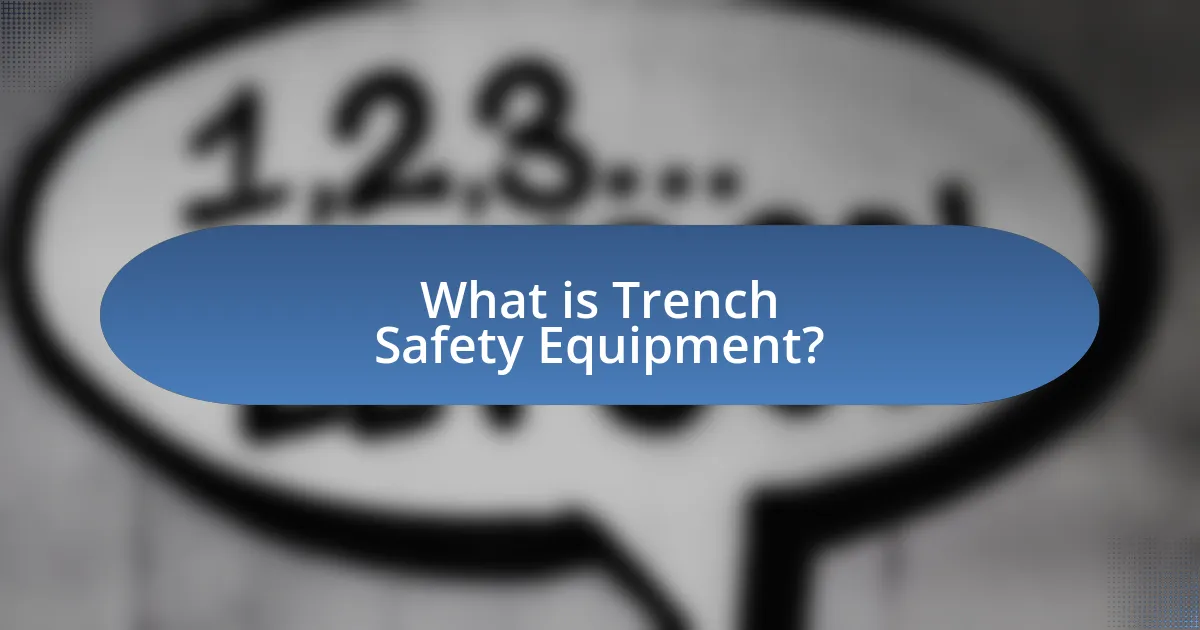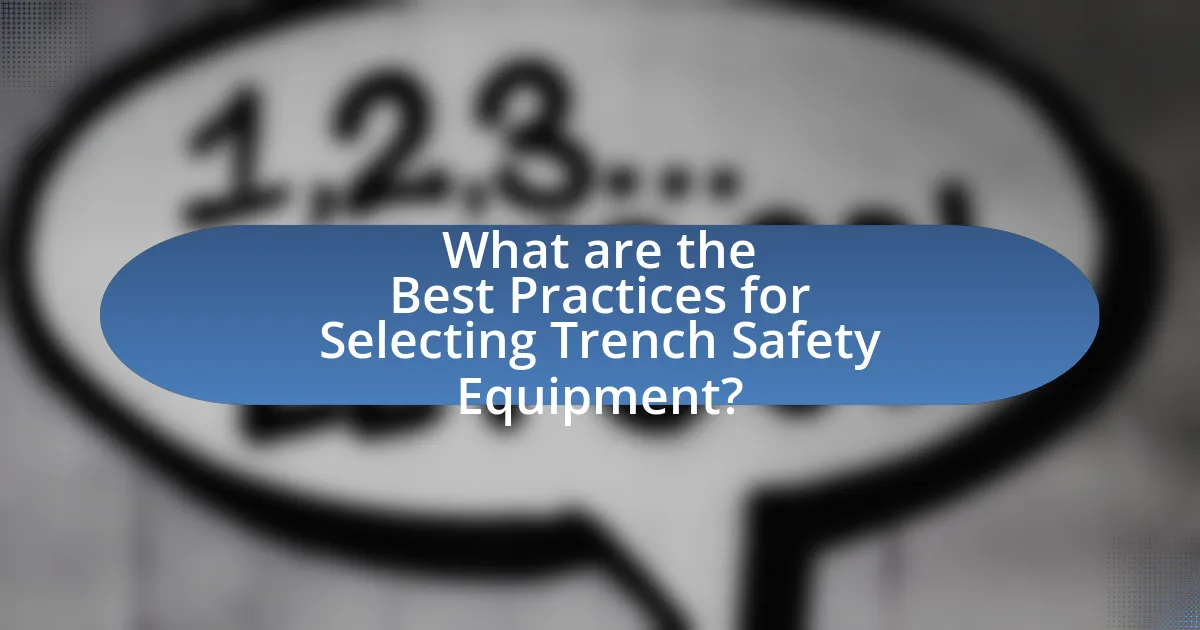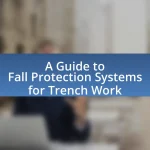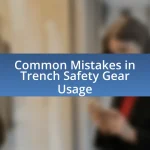Trench safety equipment is essential for protecting workers from hazards associated with trenching and excavation activities, including cave-ins, falls, and hazardous atmospheres. This article outlines the importance of trench safety equipment, such as trench boxes and shoring systems, and discusses the risks involved in trench work. It also provides guidance on assessing trench safety needs, selecting appropriate equipment based on factors like soil type and trench depth, and ensuring compliance with safety regulations. Additionally, the article emphasizes the significance of ongoing training and collaboration with safety experts to enhance safety practices in trench operations.

What is Trench Safety Equipment?
Trench safety equipment refers to the tools and systems designed to protect workers from hazards associated with trenching and excavation activities. This equipment includes trench boxes, shoring systems, and protective barriers that prevent collapses and provide safe access to workers. According to the Occupational Safety and Health Administration (OSHA), proper use of trench safety equipment can significantly reduce the risk of accidents, as trench collapses account for a substantial number of fatalities in the construction industry.
Why is Trench Safety Equipment essential for construction teams?
Trench safety equipment is essential for construction teams because it prevents accidents and fatalities associated with trench collapses. According to the Occupational Safety and Health Administration (OSHA), trench collapses can occur in as little as five seconds, leading to serious injuries or death. The use of trench safety equipment, such as shoring systems, trench boxes, and protective barriers, significantly reduces the risk of these incidents by providing structural support and ensuring worker safety. Statistics indicate that proper trench safety measures can reduce the likelihood of accidents by up to 90%, highlighting the critical importance of this equipment in safeguarding construction workers.
What are the risks associated with trench work?
The risks associated with trench work include cave-ins, falls, hazardous atmospheres, and equipment-related accidents. Cave-ins are the most significant risk, with the Occupational Safety and Health Administration (OSHA) reporting that they account for 75% of trench-related fatalities. Falls into trenches can occur due to unprotected edges or improper access, while hazardous atmospheres may arise from the presence of toxic gases or insufficient oxygen levels. Additionally, equipment-related accidents can happen when machinery operates near the trench, posing risks to workers. These risks necessitate the use of proper trench safety equipment to mitigate hazards effectively.
How does trench safety equipment mitigate these risks?
Trench safety equipment mitigates risks by providing structural support and protective barriers that prevent collapses and protect workers from falling soil. Equipment such as trench boxes and shoring systems are designed to stabilize the walls of excavations, significantly reducing the likelihood of cave-ins, which are a leading cause of fatalities in trenching operations. According to the Occupational Safety and Health Administration (OSHA), proper use of trench safety equipment can reduce the risk of accidents by ensuring that trenches are adequately supported and that workers are shielded from hazards.
What types of trench safety equipment are available?
Various types of trench safety equipment are available, including trench boxes, shoring systems, and protective helmets. Trench boxes, also known as trench shields, are designed to protect workers from cave-ins by providing a safe space within the trench. Shoring systems, which can be hydraulic or mechanical, are used to support the walls of the trench and prevent collapses. Protective helmets are essential for safeguarding workers from falling debris. According to the Occupational Safety and Health Administration (OSHA), proper use of trench safety equipment significantly reduces the risk of accidents and injuries in excavation work.
What are the different categories of trench safety equipment?
The different categories of trench safety equipment include protective systems, personal protective equipment (PPE), and monitoring devices. Protective systems, such as trench boxes and shoring, are designed to prevent collapses and protect workers within the trench. Personal protective equipment includes hard hats, safety glasses, and steel-toed boots, which safeguard workers from potential hazards. Monitoring devices, such as gas detectors and slope indicators, help assess environmental conditions and ensure safety during trench operations. These categories collectively enhance safety and compliance with regulations, such as those outlined by the Occupational Safety and Health Administration (OSHA).
How do specific types of equipment function in trench safety?
Specific types of equipment function in trench safety by providing structural support, preventing collapses, and ensuring worker safety. For instance, trench boxes, also known as trench shields, are designed to protect workers by creating a safe space within the trench, thereby preventing soil from caving in. Additionally, shoring equipment, such as hydraulic shores, supports trench walls and stabilizes the excavation site, reducing the risk of accidents. According to the Occupational Safety and Health Administration (OSHA), proper use of these safety devices can significantly lower the incidence of trench-related injuries and fatalities, highlighting their critical role in maintaining a safe work environment.
How to Assess Your Team’s Trench Safety Needs?
To assess your team’s trench safety needs, conduct a thorough evaluation of the work environment, including soil conditions, trench depth, and potential hazards. This assessment should involve identifying specific risks such as soil type, water accumulation, and nearby traffic, which can influence the safety measures required. According to OSHA regulations, trenches deeper than five feet require protective systems, emphasizing the importance of understanding the specific conditions your team will face. Additionally, consulting with safety professionals and utilizing resources like the National Institute for Occupational Safety and Health (NIOSH) can provide further guidance on best practices and equipment necessary for ensuring trench safety.
What factors should be considered when choosing trench safety equipment?
When choosing trench safety equipment, factors such as soil type, trench depth, anticipated loads, and environmental conditions must be considered. Soil type influences the stability of the trench walls; for instance, cohesive soils may require different support systems compared to granular soils. Trench depth is critical, as deeper trenches pose greater risks and may necessitate more robust protective measures. Anticipated loads, including equipment and materials above the trench, dictate the strength and type of safety equipment needed. Environmental conditions, such as weather and nearby traffic, also affect safety requirements, as wet or unstable conditions can increase the risk of collapse. These considerations ensure compliance with safety regulations and protect workers from potential hazards.
How does the depth and width of the trench influence equipment choice?
The depth and width of the trench significantly influence the choice of equipment by determining the type and size of machinery required for safe excavation and material handling. For instance, deeper trenches necessitate the use of larger excavators or backhoes that can reach greater depths while ensuring stability and safety. Additionally, wider trenches may require specialized equipment such as trench boxes or shoring systems to prevent collapses and protect workers. According to OSHA regulations, trenches deeper than five feet must have protective systems in place, which further dictates the selection of equipment to ensure compliance and safety.
What role does soil type play in selecting trench safety equipment?
Soil type significantly influences the selection of trench safety equipment by determining the stability and potential hazards of the trench environment. Different soil types, such as cohesive, granular, or mixed soils, have varying properties that affect how trenches behave under load. For instance, cohesive soils, like clay, can retain water and become unstable when wet, necessitating the use of trench boxes or shoring systems to prevent collapses. Conversely, granular soils, such as sand, may require different safety measures, like sloping or benching, to ensure stability. The Occupational Safety and Health Administration (OSHA) guidelines specify that soil classification is essential for assessing trench safety, as it directly impacts the choice of protective systems and equipment needed to safeguard workers.
How can you evaluate the safety training of your team?
To evaluate the safety training of your team, implement assessments that measure knowledge retention and practical application of safety protocols. Conduct regular quizzes and hands-on drills to gauge understanding and compliance with safety procedures. For instance, a study by the National Safety Council indicates that organizations that utilize practical assessments see a 30% increase in safety compliance among employees. Additionally, gather feedback through surveys to identify areas needing improvement, ensuring that training remains relevant and effective.
What training is necessary for effective use of trench safety equipment?
Effective use of trench safety equipment requires specialized training that includes understanding trench hazards, proper equipment usage, and emergency response procedures. This training typically encompasses OSHA regulations, which mandate that workers involved in trenching operations receive instruction on recognizing and avoiding hazards associated with trenching and excavation. Additionally, training should cover the correct installation and maintenance of protective systems, such as trench boxes and shoring, to prevent collapses. According to the National Institute for Occupational Safety and Health (NIOSH), proper training significantly reduces the risk of accidents and fatalities in trenching operations, highlighting the importance of comprehensive education in this area.
How can ongoing training improve trench safety practices?
Ongoing training can significantly improve trench safety practices by ensuring that workers are consistently updated on the latest safety protocols and techniques. Regular training sessions reinforce knowledge about hazards associated with trench work, such as cave-ins, and educate workers on the proper use of safety equipment like shoring and trench boxes. According to the Occupational Safety and Health Administration (OSHA), effective training can reduce the incidence of accidents by up to 30%, highlighting the importance of continuous education in maintaining a safe work environment.

What are the Best Practices for Selecting Trench Safety Equipment?
The best practices for selecting trench safety equipment include assessing the specific site conditions, understanding regulatory requirements, and choosing equipment that meets the needs of the workforce. Site conditions such as soil type, depth of the trench, and environmental factors dictate the type of protective systems required, such as trench boxes or shoring systems. Regulatory requirements, such as those outlined by the Occupational Safety and Health Administration (OSHA), provide guidelines on the minimum safety standards that must be met. Additionally, selecting equipment that is user-friendly and compatible with the skills of the workforce enhances safety and efficiency. For instance, OSHA mandates that trenches deeper than five feet require protective systems, emphasizing the importance of compliance in equipment selection.
How do you determine the right equipment for specific trench conditions?
To determine the right equipment for specific trench conditions, assess the soil type, trench depth, and environmental factors. Soil type influences the stability of the trench; for example, cohesive soils may require different shoring equipment compared to granular soils. Trench depth dictates the need for protective systems, as deeper trenches pose greater risks of collapse. Environmental factors, such as water presence or nearby traffic, also affect equipment choice, necessitating additional safety measures like trench boxes or shields. According to OSHA regulations, proper equipment selection is crucial for ensuring worker safety in trenching operations, highlighting the importance of these assessments.
What are the key features to look for in trench boxes and shoring systems?
Key features to look for in trench boxes and shoring systems include structural integrity, ease of installation, and compliance with safety regulations. Structural integrity ensures that the system can withstand the pressures of surrounding soil, which is critical for preventing collapses; for example, systems made from high-strength steel or aluminum are often preferred for their durability. Ease of installation is important for efficiency on job sites, with features like lightweight materials and modular designs facilitating quick setup and takedown. Compliance with safety regulations, such as those set by OSHA, guarantees that the equipment meets necessary safety standards, reducing the risk of accidents.
How can you ensure compliance with safety regulations when selecting equipment?
To ensure compliance with safety regulations when selecting equipment, conduct a thorough review of applicable safety standards and regulations relevant to the specific equipment type. This includes consulting guidelines from organizations such as the Occupational Safety and Health Administration (OSHA) and the American National Standards Institute (ANSI), which provide detailed requirements for equipment safety. Additionally, verify that the equipment has the necessary certifications and meets industry-specific safety standards, ensuring it has been tested and approved for safe use in trenching operations. Regular audits and inspections of the equipment can further confirm ongoing compliance with safety regulations.
What are common mistakes to avoid when choosing trench safety equipment?
Common mistakes to avoid when choosing trench safety equipment include neglecting to assess site-specific hazards, failing to ensure compliance with OSHA regulations, and not selecting equipment that fits the specific depth and conditions of the trench. Site-specific hazards can vary significantly, and equipment must be tailored to address risks such as soil type and potential for cave-ins. Compliance with OSHA regulations is crucial, as non-compliance can lead to fines and increased risk of accidents; for instance, OSHA mandates protective systems for trenches deeper than five feet. Additionally, using equipment that does not match the trench’s depth or conditions can compromise safety, as different types of shoring or shielding are required for varying depths and soil conditions.
How can improper equipment selection lead to safety hazards?
Improper equipment selection can lead to safety hazards by increasing the risk of accidents and injuries during trench operations. When equipment is not suited for the specific conditions of a trench, such as soil type or depth, it may fail to provide adequate support or protection, resulting in collapses or falls. For instance, using a ladder that is too short can lead to falls, while inadequate shoring equipment can cause trench walls to cave in, posing serious risks to workers. According to the Occupational Safety and Health Administration (OSHA), trench collapses account for a significant number of fatalities in construction, highlighting the critical importance of selecting appropriate equipment to mitigate these dangers.
What are the consequences of neglecting regular equipment inspections?
Neglecting regular equipment inspections can lead to severe safety hazards and operational inefficiencies. Equipment that is not regularly inspected may fail during use, resulting in accidents, injuries, or fatalities. According to the Occupational Safety and Health Administration (OSHA), improper maintenance and lack of inspections are significant contributors to workplace accidents, particularly in high-risk environments like trenching operations. Additionally, neglecting inspections can result in costly repairs and downtime, as undetected issues can escalate into major failures. Regular inspections are essential for ensuring compliance with safety regulations and maintaining the reliability of equipment, ultimately protecting workers and reducing financial liabilities.
What tips can help ensure effective trench safety equipment selection?
To ensure effective trench safety equipment selection, prioritize compliance with OSHA regulations, which mandate specific safety measures for trenching operations. Assess the trench depth and soil type to determine the appropriate protective systems, such as trench boxes or shoring equipment, as different conditions require different safety solutions. Additionally, evaluate the work environment for potential hazards like nearby traffic or overhead utilities, which may necessitate additional safety gear. Regularly inspect equipment for wear and tear, ensuring it meets safety standards, as faulty equipment can lead to accidents. Training workers on the proper use of safety equipment is crucial, as informed personnel are better equipped to recognize and mitigate risks.
How can collaboration with safety experts enhance equipment choices?
Collaboration with safety experts enhances equipment choices by ensuring that selections are informed by specialized knowledge and industry standards. Safety experts provide insights into the latest safety regulations, risk assessments, and best practices, which help organizations identify equipment that meets safety requirements and operational needs. For instance, a study by the National Institute for Occupational Safety and Health (NIOSH) highlights that involving safety professionals in equipment selection can reduce workplace accidents by up to 30%. This collaboration leads to more effective and safer equipment choices, ultimately improving overall safety performance in trench operations.
What resources are available for staying updated on trench safety equipment?
To stay updated on trench safety equipment, industry professionals can utilize resources such as the Occupational Safety and Health Administration (OSHA) website, which provides guidelines and updates on safety regulations. Additionally, organizations like the National Utility Contractors Association (NUCA) offer training programs and resources focused on trench safety. Trade publications, such as “Trenchless Technology,” also provide articles and insights on the latest equipment and safety practices. Furthermore, attending industry conferences and workshops can facilitate networking and knowledge sharing regarding advancements in trench safety equipment.


